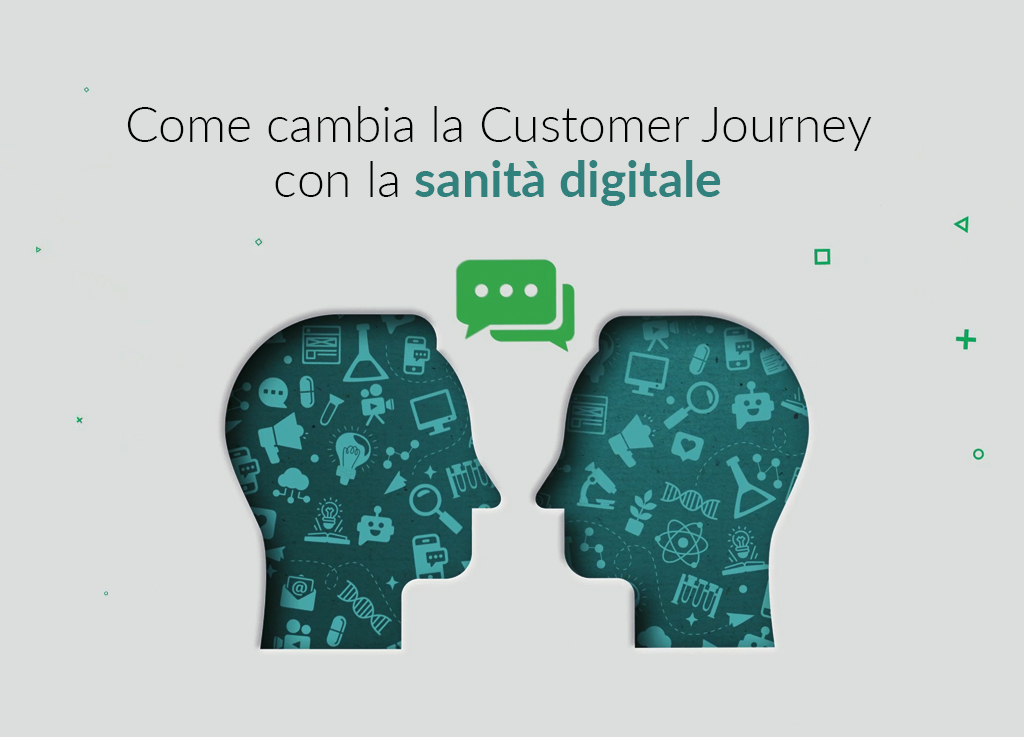The pandemic has accelerated the transformation by innovating paths for patients, physicians and caregivers. Communication and marketing strategies must also adapt.
The Covid-19 emergency has accelerated the digital transformation of Italy’s healthcare and has exposed the role of health as the pivot of our economy. The transition to Digital Health was already underway, but now it is moving forward at greater speed, changing healthcare models, patients’ Customer Journey and their relationship with practitioners.
Mobile Health
Mobile Health (M-Health) drives the evolution of Digital Health, thanks to always connected portable devices, apps and other tools that increase patients’ proactivity, while facilitating information exchange, health monitoring and access to a new healthcare model. According to the latest research by the Milan Polytechnic Digital Innovation in Healthcare Observatory, 33% of patients use lifestyle tracking apps and more than one out of five use apps to remind them when to take a medication (22%) or to monitor clinical parameters (21%). Just a few small examples of a much broader revolution.
Telemedicine
Practitioners’ use of telemedicine on a daily basis has risen from pre-Covid 10% to 30% during the emergency, according to Polytechnic sources. The most used telemedicine service is teleconsultation (47% specialists, 29% family doctors), followed by tele-visits and tele-monitoring. According to medical specialists, some 20% of checkups for chronic patients could be remotely performed by means of telemedicine solutions. Telemedicine has entered the agenda of political decision makers, who have provided for specific funding in Italy’s National Recovery and Resilience Plan (PNRR). For three out of four medical specialists, telemedicine was essential for Covid response.
Franco Gabrielli, from the National Telemedicine Center and new technologies of the Higher Institute of Health, who was interviewed by the MondoSanità portal said: “I totally disagree with the common belief that telemedicine might create a distance between patients and practitioners. Telemedicine allows to provide healthcare services, that is, to treat people by receiving almost constant information from them on their health conditions, over a day or weeks, and being able to correctly and properly contact the healthcare professionals that are needed when they are needed. By means of telemedicine, patients are followed far more closely than before”.
Infodemic
Digital has multiplied the sources of information for patients. According to Polytechnic sources, 73% of them searched online for information on correct lifestyles (compared to 60% in 2020) and 43% inquired online about the vaccination campaign. Even before the Covid emergency, the ‘Infodemic’ phenomenon was known, but then it reached significant peaks with the pandemic. With the fake news on Covid, vaccines and medications, the risks of disinformation regarding health issues have emerged more clearly.
Between November 2020 and May 2021, a study by the Foundation for Social Medicine and Technological Innovation (Mesit), jointly with the Reputation Manager and Eehta – Ceis of the Tor Vergata University of Rome, analyzed over 147,000 online contents related to Covid-19 vaccines, equivalent to around 1,000 contents per day. Among those potentially fake, one out of two regarded the danger of adverse effects (49.3%). A Censis report published in December 2021 notes that for 5.9% of Italians (about three million people) Covid simply does not exist. For 10.9% the vaccine is useless and ineffective. For 12.7%, science brings more harm than benefits.
Digital Patient Journey
In a context in which the approach to healthcare is evolving towards models focusing on patients’ needs, the Digital Patient Journey along healthcare paths – from searching for information to the diagnosis, from visits to therapies – is becoming increasingly popular. A ‘journey’ that thanks to Digital Health offers new opportunities for simplification and efficiency. Digital helps to place people at the center of care, with a new, much more active role of patients and caregivers, also innovating the doctor-patient relationship. It is a new paradigm, to which the world of marketing and digital communication is also looking with great interest.
Polk&Union
In this scenario, Polk&Union, a digital communication and integrated marketing agency, has the tools to face the ongoing evolution. As CEO Tiziano Vitale told AboutPharma, the company recently launched the Polk&Union Health division, investing in human and material resources.
A strategy to capitalize on its decades of experience in the health sector, after having accompanied and improved over all these years the digital transformation path of important Italian and international pharma companies.
Services
Polk&Union creates strategies apt to generate interactions and visibility, shapes customized social and digital communication plans, generates materials with creative and technical-scientific content, uses technology to create new platforms for dialogue and activate new phygital touch points. Qualified consultancy forms the basis for market and competition analysis, positioning studies and digital marketing strategies.
Polk&Union has been chosen by companies in the pharmaceutical sector such as Pfizer, Merck, Alfasigma, Bristol Myers Squibb, Menarini, Viatris, Medac Pharma, among others. For example, for Pfizer it supported the Vaccines Business Unit in its digital transformation and innovation process. All this starting from a digital training program tailor-made to customer needs that included as its final goal, besides that of the training itself, the development of three innovative ideas to be turned into well-defined, ready for implementation projects.
For Menarini Group it produced an awareness raising and education digital project on antibiotic resistance (AMR) and superbugs. To create the project, Polk&Union worked in a team with the Corporate Therapeutic business unit. The strategic approach developed by Polk&Union to illustrate the company’s commitment in the fight against antibiotic resistance involved the creation of a multilingual global site as its main asset. The agency developed the information architecture, all medical-scientific contents and the entire infrastructure design, creating a highly specialized storytelling that managed to clarify the characteristics of the phenomenon in a complete and accessible manner. The Polk&Union Health division supports customers in every phase of the creation and development of omnichannel communications – specialized and aimed at multiple Healthcare audiences – by promoting innovative services for digital transformation with video productions, media placement, creativity, social media, digital innovation and medical writing.




